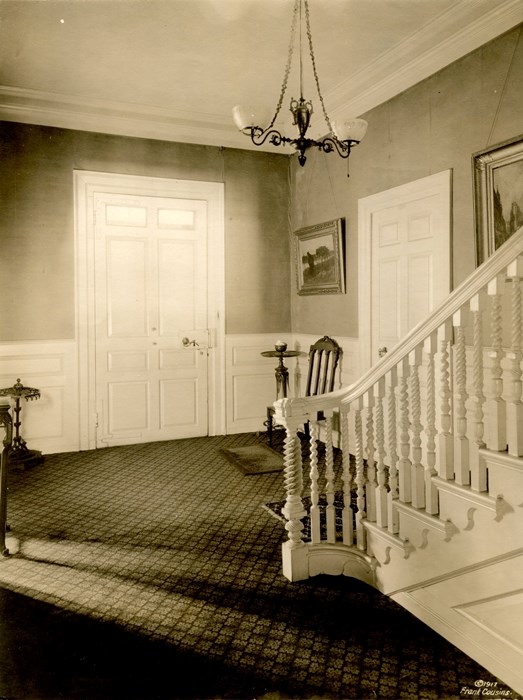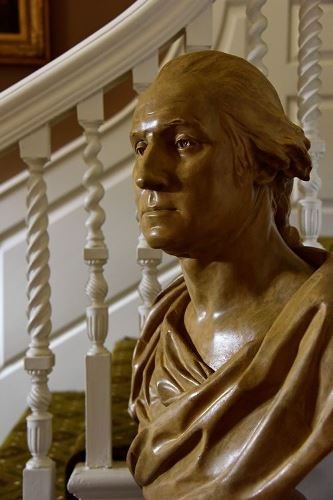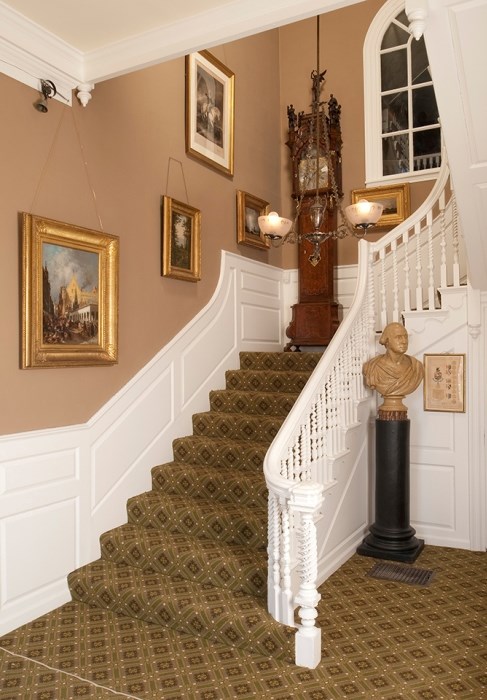
Buildings and Grounds Photograph Collection (3008-2-5-7) This room has been the formal entry since the mansion was constructed in 1759. The large front door opens onto sandstone steps and a path toward Brattle Street to the south. Doors on either side open into the parlor and study. The addition in the 1790s of a carriage circle and west side entry provided a second entry for family and guests; the Longfellows appear to have used both entrances. When the Longfellow House Trust began offering regular house tours in the mid-twentieth century, the public commonly came in through the front door. The door is no longer used as an entrance today. 
© 2015 Xiomaro "Rendered Sacred"The Longfellows recognized the historical significance of their home as George Washington's Cambridge Headquarters, and Fanny Longfellow declared in 1843 they had "no desire... to change a feature of the old countenance which Washington has rendered sacred." In 1844, the Longfellows acquired a copy of a bust of George Washington and placed it on the stair landing. The original terra-cotta bust, made in 1785 by the French sculptor Jean-Antoine Houdon, is at Mount Vernon. The family continued to add tributes to Washington over the years. A print of Washington on a horse hanging over the stairs was presented to Henry Longfellow in 1864. Alice Longfellow later hung a Washington family coat of arms behind the Houdon bust. In 1877 Longfellow acquired an ornate eighteenth-century Dutch clock that he placed in Colonial Revival fashion on his front hall stair landing, possibly inspired by the tremendous popular response to his poem "The Old Clock on the Stairs," written in 1843. (The clock that inspired the poem was in the Pittsfield, Massachusetts home of Fanny Appleton Longfellow's grandparents.) Longfellow wrote to his friend George Washington Greene,

NPS Photo / David Bohl "The Broad Hall Stair"The stairs of the front hall were captured in Longfellow's poetry. His words in "To A Child" evoke the weight of the history of the house: Once, ah, once, within these walls,
One whom memory oft recalls, The Father of his Country, dwelt. And yonder meadows broad and damp The fires of the besieging camp Encircled with a burning belt. Up and down these echoing stairs, Heavy with the weight of cares, Sounded his majestic tread; Yes, within this very room Sat he in those hours of gloom, Weary both in heart and head.
In "The Children's Hour," the stairs serve as the connection between Longfellow's study and his young daughters emerging from the nursery upstairs: From my study I see in the lamplight,
Descending the broad hall stair, Grave Alice, and laughing Allegra, And Edith with golden hair. |
Last updated: February 2, 2022
